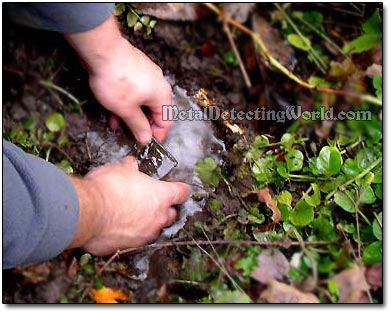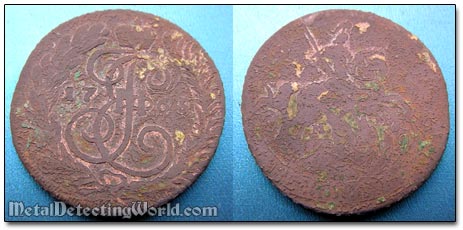Cleaning and Preservation of Coins - A Complete Guide, page 5
Important Things To Do and Consider Before Cleaning a Coin
When you dig up a silver coin while metal detecting in the field, many times you can not make out the date or mint mark. So you are tempted to rub it with your fingers or on your pants to find out. At this point STOP! DO NOT TOUCH THE SURFACE AT ALL if you want this coin to remain valuable! Keep the dirt on the coin and place it in a container with cotton balls to protect it. I always keep a medicine container in my belt pouch for this purpose.
It is known that just wiping the dirt from a rare coin can drop its grade and its value several hundred dollars! It is better to read dates and mint marks of all silver coins at home after you have had time to carefully remove the dirt without damaging the coin. A coin does not have to be minted in the late 1600's to be extremely rare or valuable. To determine whether your coin is valuable or not, you can visit my Numismatic Corner - a guide to the US and other coins, where you will find US coin values, coin images, numismatic information and specifics.
Cleaning bronze and brass relics should be considered carefully, and the relics should be treated the same way as coins, tokens and medals. Leave the dirt on relics and artifacts until you bring them home and can examine and clean them with care.
A Valuable Relic or Coin Should NOT Be Cleaned This Way

It is extremely important to familiarize yourself with all types of coins that you might find in your area. For example, the current edition of the "Red Book" - A Guide Book of United States Coins by R.S. Yeoman is the best reference for learning about the US coin types and their histories, retail values, mintage totals and quick reference grading. There are many other fine books on the market which are definitive about specific types of coins for the specialized coin collector.
In case of cleaning a rare silver or copper coin, you should discard the belief of novice coin collectors that the more a coin shines, the more beautiful it must be. If a rare coin is energetically polished, its value will go down dramatically.
Standards for Aesthetic Appearance of Coins:
• Newly minted silver coins should be gleaming and bright.
• Silver coins, fifty to one hundred years old, are lightly tarnished.
• Silver coins over one hundred years old show a gradual darkening from age.
• True healthy patina of copper and bronze coins must always be left alone (see more details on page 3).
In general, clearly visible dirt should not be left on coins.
If you have any coin you suspect is very valuable and you intend to sell it, DO NOT EVEN RINSE IT IN WATER! Keep the coin secure and take it to a reputable coin dealer.
Important Things To Do and Consider Before Cleaning a Coin
1) Cleaning a coin, especially by applying some MECHANICAL cleaning methods, will greatly DECREASE its value in 90% of all cases.
2) A coin should be closely examined to determine its numismatic value (key dates, other characteristics that make this coin valuable), metal or composition of alloy the coin is made of, surface condition (including small dirt encrustation, uneven toning and granules on the surface), level of attrition (the state of being worn away), amount of heavy oxidation, encrustation and hard deposits that might have damaged the coin's design and substratum (an underlying layer) underneath, the extent of any visible damage caused by soil minerals and other factors.
Upon making a decision on whether to clean the coin or not, it is always a matter of taste and judgement. For instance, if you are going to keep the coin as a sentimental item in your collection, it is ok to clean it a little just to give it a nice aesthetic appearance.
3) Only badly tarnished silver coins and hard-encrusted copper and bronze coins may benefit from careful and professional cleaning.
4) Worthless or badly damaged coins are ok to clean and should be used for experimenting with various cleaning methods in order to learn cleaning techniques and determine the most appropriate cleaning method for a valuable specie of the same particular type.
5) Dug GOLD coins do not require chemical and electrochemical cleaning in 99.9% of all cases. Soft brushing with soapy water is all that is needed to remove any dirt off the gold coins.
6) Dug SILVER coins, if not seriously damaged by Horn Silver, are easy to clean in 90% of all cases.
7) Dug COPPER and copper-alloyed coins are the hardest to clean as they are the most susceptible to environmental damage (corrosion and oxidation) resulting in thick built-up layers of encrustation (false patina) and other hard deposits that are likely to destroy surface features or even the most of base metal underneath. Conservation of such "problem coins" is extremely difficult and time consuming, and requires high expertise and skills in coin cleaning.
8) Study various cleaning methods to select the most appropriate one for your coin and make sure you know what you are about to do before starting the process.
9) If, at some point during the cleaning process, you are not sure about what you are doing or what to do next, STOP! It is better and safer to "underclean" than "overclean".
10) Learn and practice all safety precautions that should be observed during the coin cleaning process to prevent any personal injury to yourself or others, and property damage.
11) Learn and implement appropriate coin conservation procedures and techniques to protect your cleaned coins against future deterioration. And last but not least, find the best solutions for storing, displaying, and handling your coins safely.
On the following pages of this section, you will find all cleaning methods and tutorials with "How-To" information applicable to common silver, copper, nickel and other coins.
NOTE: For both mechanical and chemical cleaning of coins the same rule applies: if a treatment is not completely safe, a test treatment must be performed first. It is the best to experiment on coins such as this 1763 2 Kopeks copper coin from which thick encrustation was removed only to reveal the coin's damaged surface - "eaten" by the soil minerals.
Copper Coin Obliterated by Soil Minerals
